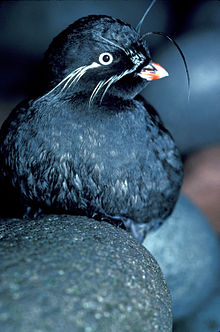| Aethia |
|---|
 |
| Aethia pygmaea |
| Scientific classification |
|---|
| Kingdom: | Animalia |
| Phylum: | Chordata |
| Class: | Aves |
| Order: | Charadriiformes |
| Family: | Alcidae |
| Genus: | Aethia
Merrem, 1788 |
| Species |
|---|
Aethia cristatella
Aethia psittacula
Aethia pusilla
Aethia pygmaea
|
Taxonomy and Evolution

Current accepted taxonomy of the Alcidae with
Aethia shown in blue. Modified from Friesen et al. 1996. Mol. Biol. Evol. 13, 359-367.
The
genus Aethia did not enter into widespread use until the 1960s.Initially, the auklets were placed in
Alca, but later reorganized into genera including:
Simorhynchus,
Phaleris and
Cyclorhynchus.
Cyclorhynchus is still occasionally used for the Parakeet Auklet.
Fossil record
The first undisputed auk
fossils are from the middle
Miocene (15 million years ago).The first
Aethia fossils date from the late
Miocene (10-15 million years ago) and the four species likely diverged rapidly about 5 million years ago.
Species
There are four species of Aethia.
Least Auklet Aethia pusilla
Crested Auklet Aethia cristatella
Whiskered Auklet Aethia pygmaea
Parakeet Auklet Aethia psittacula
Distribution
Population Estimates
Censusing breeding auklets can be difficult because they nest in hidden crevices. At present, population estimates are:
- Least Auklet - 20,000,000+
- Whiskered Auklet - 100,000 - 250,000
- Crested Auklet - 5,000,000 - 10,000,000
- Parakeet Auklet - 1,000,000 - 2,000,000
Breeding Season
Aethia auklets are endemic to the North Pacific Ocean and Sea of Okhostk with notable Asian colonies in the Kuril Islands, Commander Islands, along the Kamchatka and Chukota Peninsulas. In North America, large colonies are in the
Aleutian Islands (
Buldir,
Kiska,Semisopochnoi and Gareloi) to the Gulf of Alaska and north to the islands of the
Bering Sea (
St. Lawrence Island, Pribilof Islands, St. Matthew Island).
Auklets are have high site
fidelity, at both the colony and crevice level, although there can be a high
divorce rate of up to 33% in Least and Crested Auklets when both mates survive.
Winter Distribution
Winter distribution of auklets is poorly known. Whiskered Auklets likely winter near to breeding colonies and many were reported by Aleuts to winter in the general area. Auklets from the northern Bering Sea must move further south because of
pack ice surrounding colonies during the winter.
Breeding
Auklets are typically very social and nest in dense colonies (Parakeet Auklets are more dispersed). All have some form of facial ornamentation such as large crests (Whiskered and Crested Auklets), auricular plumes (all four species), and
Crested and Whiskered Aukletshave a tangerine-scented odour which may function in mate choice or species recognition, although this requires more study.
All
Aethia auklets lay one white egg in a natural crevice and incubate for 25–36 days, after which, a semi-precocial chick emerges and
fledges after 25–35 days. Age at first breeding is estimated at 3–5 years.
Colony sizes are highly variable, and range from less than 100 individuals to over 1 million, although
Least and Crested Auklets tend to nest in greater density than
Parakeet and Whiskered Auklets.
Diet
Threats and Conservation
Because they nest in crevices, auklets are vulnerable to predation by
rats, and have been extirpated from some islands that contained Arctic Foxes introduced for farming. Eradication of rats from
Rat Island was completed in 2008 and 2009.
The large colony at Sirius Point,
Kiska Island, Alaska (perhaps the largest auklet colony in the world) experienced almost complete breeding failure in 2001 and 2002 because of rat predation and disturbance and has been the focus of researchers at
Memorial University of Newfoundland.











